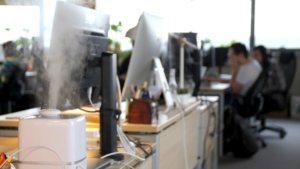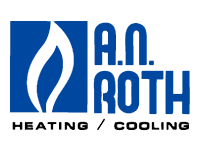Indoor Air Quality: Clean Office
Over the last year, many people have become aware of the need to consider the air quality in the home. As the United States moves towards reopening post-pandemic, more are becoming aware of the need to consider indoor air quality in public spaces, especially offices and schools.
Americans spend, on average, about 90% of their time inside. Between homes, offices, schools, and other public buildings, most of the air we breathe is indoor air. Additionally, studies indicate that indoor air is often significantly more polluted than outdoor air, even in the most industrialized cities. For this reason, indoor air pollution can have more of an impact on our health than outdoor air pollution. Indoor air quality is influenced by many factors, such as the type of building, age, humidity levels, filtration, ventilation, and more.

Sick building syndrome usually presents as headaches, nausea, respiratory irritation, dizziness, and fatigue.
Higher-risk populations are more likely to experience the effects of any pollutants, for example, children, the elderly, and immunocompromised individuals. However, anyone who experiences prolonged exposure to polluted air has the potential to experience health effects. These can range from relatively mild to life-threatening depending on the person, the type of pollutant, and the exposure. There is even a condition called sick building syndrome, or SBS. SBS refers to the symptoms of illness experienced in connection to a particular building.
What’s in the Air?
Air pollutants are minuscule, often invisible to the naked eye. The EPA identifies six common pollutants which are regulated and used as indicators of air quality. Particulate matter (or particle pollution) and Volatile Organic Compounds, or VOCs, are two of the most common categories of indoor air pollutants.
Particle Pollution

Particle pollution is a huge problem worldwide.
Particle pollution is classified into three categories based on size: coarse particulate matter, fine particulate matter, and ultrafine particles. These encompass a range of pollutants, many of which are common in offices. For example, the air in many offices contains biological pollutants like bacteria, dust, mold spores, pollen, and cockroaches particulates. Buildings near busy roads or industrial areas are also likely to have fine and ultrafine particles from vehicle exhaust, power plant emissions, and smoke.
Out of all of the most common air pollutants, particulate matter causes the most adverse health reactions worldwide. This kind of pollution is associated with a range of respiratory problems like bronchitis, asthma, and increased mortality from COVID-19. In addition to respiratory and pulmonary problems, particle pollution is also closely linked to cardiovascular disease.
Volatile Organic Compounds
VOCs are gases emitted primarily from human-made sources. Sources of VOCs include cleaning products, pesticides, building materials, new furnishings, carpets, paint, copy machines, and more. As you can imagine, VOCs are common in office buildings, and especially in new developments.
Exposure to VOCs causes ear, nose, and throat irritation in most people. VOC exposure can damage the liver, kidneys, and central nervous system and cause certain cancers.
Work-Related Problems
In addition to the acute symptoms of sick building syndrome, low indoor air quality causes many other issues that can impact employees. With the advent of COVID-19, a serious concern is potential infectious disease transmission. Poor ventilation has been linked to the transmission of other diseases like severe acute respiratory syndrome (SARS), hantavirus pulmonary syndrome, and Norovirus.
Among students, poor indoor air quality increases absenteeism and lowers test scores. Alternatively, among employees, higher indoor air quality results in better cognitive function, decision-making ability, and strategic thinking. In other words, it’s in everyone’s best interest, and a sound investment, to ensure that your office building has good air quality.
How Can We Fix This?
Air-Quality Assessment
 If you’re interested in improving the air quality of your office building, a good first step is to have your building professionally evaluated through an on-site air quality assessment. This will allow you to determine the current air quality, pinpoint potential issues, and determine solutions.
If you’re interested in improving the air quality of your office building, a good first step is to have your building professionally evaluated through an on-site air quality assessment. This will allow you to determine the current air quality, pinpoint potential issues, and determine solutions.
An air-quality consultation will help identify pollution sources, whether they originate indoors or outdoors. It will also consider the age and condition of the HVAC system and inspect the air handlers and distribution systems. A professional will determine the health of your building and make recommendations in regard to ventilation, air filtration/purification, as well as temperature and humidity levels.
Air Filtration

The expense of clean office air is offset by saved human resource costs.
The most crucial solution for low indoor air quality is an HVAC system that effectively filters most airborne pollutants. We previously wrote about the capabilities of the IQAir Perfect 16, which is a high-performance filtration system available for homes and commercial developments. It removes not only 95% of particles larger than 0.3 microns, but it’s also 85% effective in removing particles above 0.003 microns (the smallest that exist.) And because it’s installed into the existing HVAC system, the IQAir Perfect 16 continuously delivers fresh, medical-grade clean air throughout the building.
Once you’ve upgraded your air filtration system, regular maintenance and changing the air filters are vital to keeping any filtration system in top condition. Installing an indoor air quality monitor will also keep track of pollutants and report fluctuations.
UV Purification
The IQAir Perfect 16 is not the only way to improve air quality in your home or office. There are personal air purifiers, humidifiers, dehumidifiers, and UV germicidal air purification systems. UV purification systems use ultraviolet light to render the environment inhospitable for a range of microorganisms.

Clean office air enhances productivity and decreases absenteeism.
This technology stops molds, viruses, and bacteria from recirculating in your air, resulting in reduced allergy and asthma symptoms, and a reduced risk of infectious disease transmission.
Get Started
The professionals at A.N. Roth Heating & Cooling are Louisville’s air filtration and purification experts, offering solutions for residences, offices, schools, and more. If you’re ready to get started, contact A.N. Roth Heating & Cooling today, or get started with our free virtual estimates.
